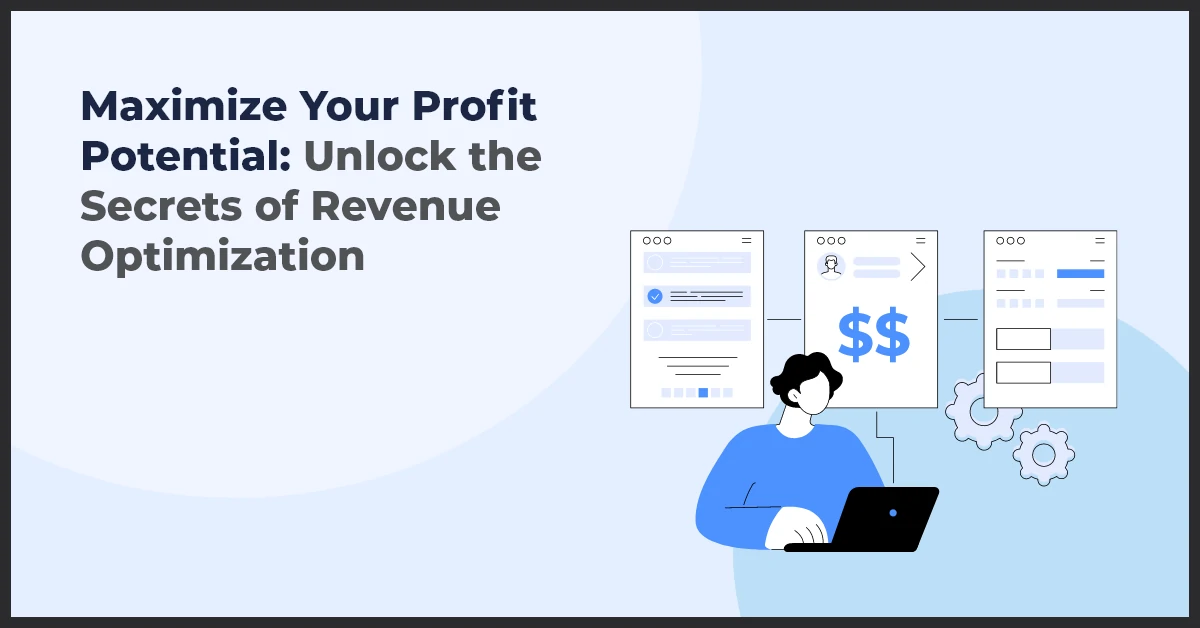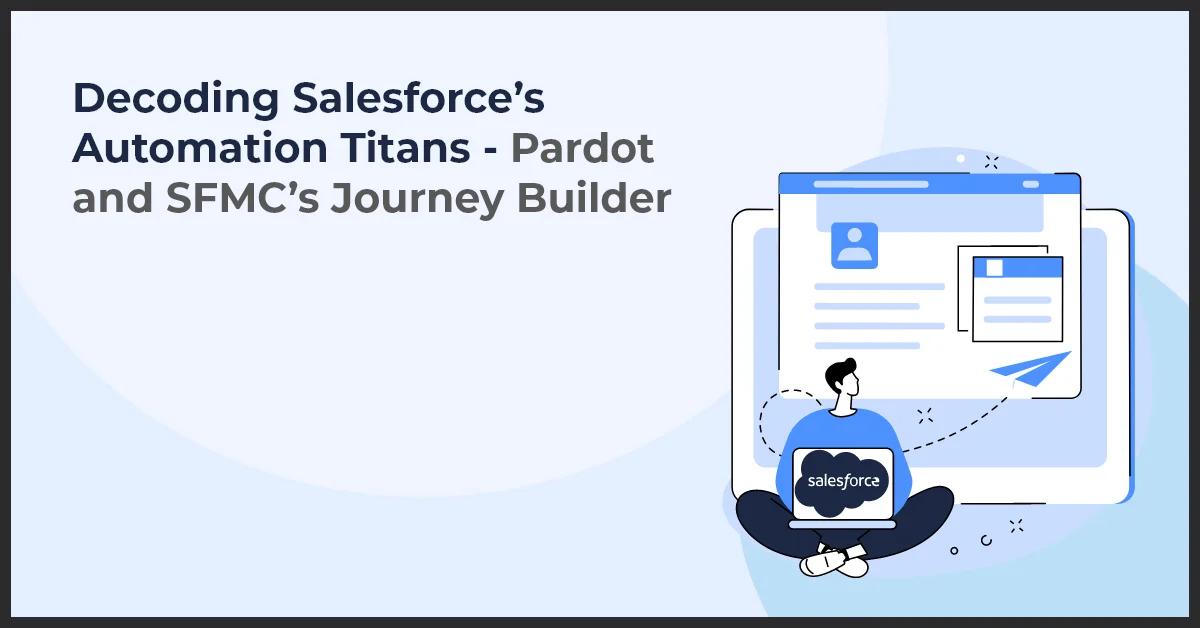Maximize Your Profit Potential: Unlock the Secrets of Revenue Optimization

Published on: October 30, 2023
Updated on: July 15, 2024
778 Views
- Salesforce
10 min read
Are you looking for ways to skyrocket your business's profitability? Look no further! In this comprehensive guide, we will delve into the world of revenue optimization and how it can revolutionize your company's success. Revenue optimization is the strategic process of maximizing your earnings by optimizing various components related to revenue, customers, data, optimization techniques, and sales. Understanding these key components is crucial for staying ahead of the competition and achieving your financial goals.
Importance of Revenue Optimization
Revenue optimization goes beyond simple revenue generation. It focuses on fine-tuning your business operations to extract the maximum value out of every aspect influencing your revenue streams. By implementing effective revenue optimization strategies, you can ensure your business thrives in a highly competitive market.
Key Components of Revenue Optimization
1. Revenue: This component involves understanding and capitalizing on different revenue sources within your business, such as product sales, subscriptions, ad revenue, and other income streams.
2. Customer: Your customers are the lifeblood of your business. Optimizing your customer acquisition, retention, satisfaction, and loyalty are essential for increasing revenue and driving long-term growth.
3. Data: Data is the foundation of revenue optimization. By harnessing the power of analytics and insights, you can make informed decisions, personalize experiences, and improve your overall revenue generation capabilities.
4. Optimization: This component involves fine-tuning your business processes, strategies, and operations to achieve optimal revenue growth. By constantly testing, analyzing, and refining your approach, you can uncover hidden opportunities and overcome operational inefficiencies.
5. Sales: Effective sales strategies and techniques are pivotal in revenue optimization. Streamlining your sales processes, empowering your sales team, and optimizing conversion rates are essential for driving revenue growth and maximizing profitability.
So, if you're ready to take your business to new heights and unlock its true profit potential, join us on this revenue optimization journey where we'll dive deep into each component and equip you with the tools and strategies needed to boost your bottom line. Don't miss out on this opportunity to transform your business into a revenue-generating machine!
Understanding Revenue Optimization Strategies
A. Revenue Management Systems
Revenue management systems play a crucial role in revenue optimization. These systems are designed to effectively manage and maximize revenue for businesses.
1. Definition and Purpose
Revenue management systems refer to the set of strategies, tools, and techniques that businesses use to price their products or services based on market demand, customer behavior, and competition. The main purpose of these systems is to improve revenue generation and profitability.
2. Benefits and Challenges
Implementing revenue management systems offers several benefits, including:
- Increase in revenue and profitability
- Better understanding of customer behavior and demand patterns
- Optimized pricing strategies to maximize revenue
- Improvement in sales performance and revenue growth
However, businesses may face challenges in implementing revenue management systems, such as:
- Complexity of data analysis and interpretation
- Integration of the system with existing processes and technologies
- Resistance to change within the organization
3. Types of Revenue Management Systems
Revenue management systems can be categorized into two main types:
- Yield Management: This type of system focuses on optimizing revenue by managing capacity and pricing. It involves setting different prices based on factors such as time, demand, and customer segments.
- Pricing Analytics: This type of system utilizes data analytics to analyze market trends, customer behavior, and competitor pricing to determine the optimal pricing strategy for maximizing revenue.
B. Demand Forecasting
Demand forecasting plays a critical role in revenue optimization. By accurately predicting future demand, businesses can make informed decisions to optimize their revenue generation strategies.
1. Importance in Revenue Optimization
Demand forecasting is essential for revenue optimization as it allows businesses to:
- Align inventory levels and production capacity with expected demand
- Optimize pricing strategies based on anticipated customer demand
- Plan marketing and promotional activities to attract and retain customers
2. Predictive Analytics and Forecasting Techniques
Businesses utilize predictive analytics and various forecasting techniques to anticipate demand accurately. These techniques involve analyzing historical data, market trends, customer preferences, and external factors to make predictions about future demand.
3. Optimizing Sales Performance for Revenue Growth
Revenue optimization strategies also involve optimizing sales performance. By implementing sales performance optimization techniques, businesses can enhance revenue generation by improving sales efficiency, effectiveness, and customer satisfaction.
4. Enhancing Pricing Strategy for Revenue Maximization
Pricing strategy plays a pivotal role in revenue optimization. Effective pricing strategies involve analyzing market dynamics, competitor pricing, customer willingness to pay, and value perception to determine the optimal price points that maximize revenue and profitability.
5. Leveraging Data Analytics for Revenue Optimization
Data analytics plays a crucial role in revenue optimization. By leveraging data analytics, businesses can gain valuable insights into customer behavior, market trends, and competitor strategies, enabling them to make data-driven decisions to optimize their revenue generation.
6. Strategies for Optimization in Other Areas
Aside from pricing and sales optimization, businesses can also apply revenue optimization strategies in other areas such as:
- Supply chain management
- Marketing and advertising
- Customer relationship management
7. Implementing Revenue Optimization Process in Businesses
Implementing revenue optimization requires a structured process. Businesses should:
- Identify revenue drivers and key performance indicators
- Collect and analyze relevant data
- Develop revenue optimization strategies and action plans
- Monitor and evaluate performance
- Continuously improve and adapt strategies based on results
Revenue optimization strategies are essential for businesses to maximize their revenue and profitability. By implementing revenue management systems, conducting effective demand forecasting, and optimizing sales performance and pricing strategies, businesses can achieve sustainable revenue growth and competitive advantage.
Optimizing Sales Performance for Revenue Growth
Sales Performance Analysis
When it comes to revenue optimization, analyzing sales performance is crucial. By evaluating key metrics and KPIs, businesses can gain valuable insights into their sales processes. This analysis helps identify areas of improvement and uncover sales opportunities and challenges.
- Evaluating Key Metrics and KPIs
- Identifying Sales Opportunities and Challenges
Customer Segmentation for Sales Growth
Customer segmentation plays a vital role in achieving revenue growth. By dividing customers into distinct groups based on various criteria, businesses can better understand their target audience and tailor their sales strategies accordingly.
- Importance of Customer Segmentation
- Effective Segmentation Techniques
Cross-selling and Upselling Strategies
Implementing cross-selling and upselling techniques can significantly contribute to revenue optimization. Cross-selling involves offering related products or services to customers, while upselling aims to upgrade customers to higher-priced offerings. These strategies not only boost sales but also enhance customer satisfaction and loyalty.
- Definition and Benefits
- Implementing Effective Cross-selling and Upselling Tactics
Leveraging Data Analytics for Revenue Optimization
Data analytics is a powerful tool that businesses can use to optimize their revenue and drive growth. By analyzing large sets of data, organizations can gain valuable insights into customer behavior, preferences, and trends. These insights can then be leveraged to make informed decisions and implement strategies that maximize revenue.
Data Analytics and Business Intelligence
Business intelligence involves using data analytics to gather and analyze information about a company’s operations, customers, and market trends. It helps businesses make data-driven decisions and gain a competitive edge. By leveraging business intelligence tools, organizations can identify patterns, trends, and opportunities that may otherwise go unnoticed.
The benefits of data analytics and business intelligence include:
- Improved decision-making capabilities
- Increased productivity and efficiency
- Better understanding of customer behavior
- Identification of new revenue streams
Utilizing business intelligence tools is crucial for revenue optimization. These tools allow businesses to aggregate and analyze data from a variety of sources, such as customer transactions, website interactions, and social media engagement. With these insights, organizations can develop targeted strategies to optimize revenue.
Using Competitive Analysis for Revenue Growth
Competitive analysis involves analyzing competitors' pricing, promotions, and marketing campaigns to gain a better understanding of the market landscape. By examining the strategies and tactics of competitors, businesses can identify gaps in the market and uncover opportunities for revenue growth.
Key steps in using competitive analysis for revenue growth include:
- Analyzing Competitors' Pricing, Promotions, and Campaigns: By studying the pricing strategies, promotional activities, and marketing campaigns of competitors, businesses can gain insight into industry trends and consumer preferences.
- Identifying Competitive Advantages and Opportunities: Through competitive analysis, organizations can identify areas where they have a competitive advantage and develop strategies to leverage these strengths for revenue optimization.
Competitive analysis provides valuable insights that can inform revenue optimization strategies. By understanding how competitors are positioning themselves in the market, businesses can adapt their own pricing, promotions, and campaigns to attract customers and maximize revenue.
Strategies for Optimization in Other Areas
While optimizing sales performance, pricing strategy, and leveraging data analytics are crucial for revenue optimization, there are several other areas that businesses can focus on to further enhance their revenue growth. In this section, we will explore some strategies for optimization in these other areas.
A. Marketing Optimization
1. Optimizing Marketing Campaigns for Revenue Growth
Effective marketing campaigns play a pivotal role in driving revenue growth. By continuously analyzing and refining marketing strategies, businesses can ensure that their campaigns are reaching the right audience at the right time. Incorporating customer insights and utilizing A/B testing can also help optimize marketing campaigns for increased revenue.
2. Efficiently Allocating Marketing Budgets
Optimizing marketing budgets is crucial for revenue optimization. By carefully allocating marketing resources to high-performing channels and campaigns, businesses can maximize their return on investment. Regularly reviewing and adjusting marketing budgets based on performance metrics can help ensure that resources are being utilized effectively.
B. Inventory Management for Revenue Optimization
1. Importance of Effective Inventory Management
Effective inventory management is essential for revenue optimization. By maintaining optimal inventory levels, businesses can avoid stockouts while minimizing holding costs. Implementing inventory tracking systems and demand forecasting techniques can help ensure that inventory levels are balanced to meet customer demand.
2. Strategies for Balancing Inventory Levels and Demand
To optimize revenue, businesses need to strike a balance between inventory levels and customer demand. Implementing just-in-time inventory practices, establishing strategic partnerships with suppliers, and utilizing inventory optimization software are effective strategies for achieving this balance. By closely monitoring demand patterns and adjusting inventory levels accordingly, businesses can optimize revenue while minimizing carrying costs.
C. Cost Reduction Strategies
1. Cost-cutting Techniques for Revenue Optimization
Implementing cost reduction strategies is vital for revenue optimization. By identifying areas of inefficiency and implementing cost-cutting measures, businesses can increase their profit margins. Some cost-cutting techniques include renegotiating supplier contracts, streamlining internal processes, and optimizing resource allocation.
2. Balancing Cost Reduction and Quality
While reducing costs is important, it's crucial to maintain the quality of products and services. Finding the right balance between cost reduction and maintaining quality standards is essential for revenue optimization. By regularly evaluating suppliers, implementing quality control measures, and seeking cost-effective alternatives, businesses can achieve cost reduction without compromising quality.
Conclusion
In conclusion, revenue optimization is a crucial aspect of any business that aims to maximize its revenue and achieve long-term growth. By implementing various strategies and tactics discussed in this content piece, businesses can enhance their sales performance, pricing strategy, and leverage data analytics to improve overall revenue generation.
It is important to continuously optimize revenue and adapt to the ever-changing market dynamics. By regularly reviewing and recalibrating revenue optimization strategies, businesses can ensure sustained growth and competitiveness in the industry.
Remember, revenue optimization is an ongoing process that requires dedication, analysis, and flexibility. By continuously monitoring market trends, customer behavior, and implementing data-driven insights, businesses can stay ahead of the competition and unlock their full revenue potential.
Frequently Asked Questions
A revenue optimization strategy maximizes revenue generation by identifying and implementing tactics to increase sales, improve pricing strategies, enhance customer retention, optimize operational efficiencies, and leverage data analytics for informed decision-making and growth. It aims to maximize profitability and sustain long-term business success.
Customer segmentation allows businesses to categorize customers based on demographics, behaviors, needs, and preferences, enabling targeted marketing campaigns, personalized offerings, and optimized pricing strategies to maximize revenue from different customer segments.
Common challenges in revenue optimization include insufficient data quality, pricing complexity, competitive pressures, market volatility, organizational silos, resistance to change, and balancing short-term revenue goals with long-term profitability.
Revenue optimization impacts pricing decisions by guiding businesses to set optimal prices that balance profitability with market competitiveness, customer value perception, and demand elasticity, ensuring revenue maximization across different market segments.
Businesses can identify revenue optimization opportunities through data analysis, market research, customer feedback, competitive analysis, pricing experiments, and leveraging advanced analytics and business intelligence tools.
Businesses can measure the success of revenue optimization efforts through key performance indicators (KPIs) such as revenue growth rate, average order value (AOV), customer lifetime value (CLV), conversion rates, profit margins, and return on investment (ROI).



